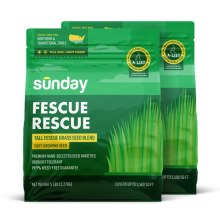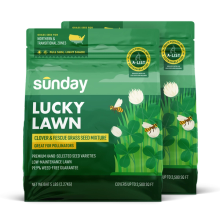Psst. Looking for Bermuda Time Grass Seed Instructions?
When to seed your cool-season lawn
You can seed cool-season grasses when temperatures consistently maintain between 55-75° F. Sunday cool-season grass seeds include:
If you seed cool-season grasses before optimal growing temperatures, the seed may not be successful, and you may have to reseed.
Sunday Tip:
Not sure which Sunday seed mix is right for your lawn? Check out Sunday's Seed Finder Tool!
How to seed your cool-season lawn
Prep lawn
Prep your lawn and soil for seed based on the type of seeding you’re doing.
For overseeding (or applying seed over an existing lawn): Mow slightly lower than normal, and remove grass clippings and debris. This helps your seeds reach the soil level! Prep any thinning or bare soil areas by lightly raking the soil.

For seeding a new area (or mostly bare soil): Lightly rake or till the top 2–3 inches of soil to ensure the seed will be planted directly into fresh soil.

Find your seed rate
Apply grass seed according to the recommended rate on the label, or use our seeding rate guide below!
For maintenance seeding or overseeding: 2 lbs. per 1000 sq. ft. for all seeds
For heavy repair, extremely weedy lawns, and new lawns, we recommend seeding at these rates*:
- Fescue Rescue: 8 lbs. per 1000 sq. ft.
- Shade Select: 5 lbs. per 1000 sq. ft.
- Lucky Lawn: 5 lbs. per 1000 sq. ft.
- Pet Lawn: 8 lbs. per 1000 sq. ft.
- Kentucky’s Best 2 lbs. per 1000 sq. ft.
*For size reference: 1000 sq. ft. is about the size of a volleyball court!
Sunday Tip:
Looking for Bermuda Time Grass Seed Instructions?
Spread seeds

Use a rotary or drop spreader to spread seeds evenly at the correct rate for best results.
- Fill up your spreader and start on your spreader’s lowest setting
- Slowly increase as needed to reach the desired coverage and seed rate
- Spread evenly across your lawn until full coverage is reached—refill the spreader as needed
Water correctly

Water the seed thoroughly but gently.
- For overseeding: Water in the seed and continue to water according to your regular schedule. This seeding method doesn’t require daily watering, but it may be possible in dry climates.
- For new lawns or bare soil: Water 1–2 times daily for 2-3 weeks until the grass is established (about 2"), then reduce watering to your regular schedule. Avoid water pooling, but keep the soil moist.
Sunday Tip:
After overseeding, you can cover the seed with a thin layer of straw, compost, topsoil, or mulch to protect seeds, hold moisture, and help increase the germination rate.
Cool-season grass seeding tips
- Water your lawn the day before or a few hours before seeding
- Keep the soil moist until the seeds germinate
- Apply at the recommended rate for even growth; too much seed can increase problems, but under-application causes thin growth
- If seeding a new lawn, wait until 60% of seeds germinate before fertilizing
- You can start mowing new grass once it reaches proper mowing height
Sunday grass seed FAQs
How long does grass take to germinate?
- Fescues: up to 12 days
- Perennial rye: up to 7 days
- Kentucky Bluegrass: up to 21 days
How to water new grass seed
For new lawns or bare spots: Water once or twice daily until the new grass is about 2". Once the grass is established, reduce your watering to a regular schedule.
For overseeding: Maintain a regular watering schedule. Depending on where you live, this typically looks like watering 1/2 inch about 1-3 times a week when it's not raining.
Additional tips to keep in mind:
- Use a lighter sprinkler or hose setting to water to avoid washing away seed
- Avoid water pooling seeded areas—keep the soil moist, not wet
How do I use grass seed with other Sunday products?
Sunday cool-season grass seeds are made to work with Sunday custom lawn plans, fertilizers, and other Sunday lawn products.
For best results, use grass seed, fertilizer, weed control, and seeding support lawn treatments like Lawn Aid. These will help you feed properly, reduce weeds, and establish grass seed in your lawn.
Where can I buy Sunday grass seed?
You can purchase grass seed in a Sunday custom lawn plan or below!

Fescue Rescue Grass Seed (2-pack)
- Drought tolerant
- Medium sunshine
- Medium water
- 99.9% weed-free guarantee
- Northern, transitional climate

Shade Select Grass Seed (2-pack)
- Low sunshine
- Low water needs
- 99.9% weed-free guarantee
- Northern, transitional climates

Lucky Lawn Grass Seed (2-pack)
- Pollinator-friendly
- Medium sunshine
- Medium water
- 99.9% weed-free guarantee
- Northern, transitional climates

Kentucky's Best Grass Seed (2-pack)
- Excellent cold tolerance
- High sunshine
- High water needs
- 99.9% weed-free guarantee
- For northern climates

Pet Lawn Grass Seed (2-pack)
- Proven dog spot resistance
- Proprietary blend of tetraploid perennial ryegrass and select tall fescue
- One five-pound bag can overseed up to 2,500 square feet
- One five-pound bag can seed 1,250 square feet of new lawn
- Grass types: tall fescue, perennial ryegrass
What about Sunday warm-season grass seed?
Looking for Bermuda Time Grass Seed Instructions? Find them at getsunday.com/shed/product-instructions/bermuda-time-grass-seed-instructions.











